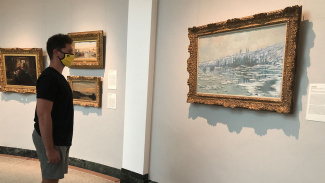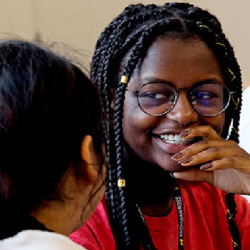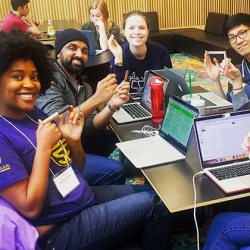Michigan Ross Sophomores Reflect on their Personal Leadership Styles Through Engaging in Art Activity at Three U-M Museums

To kick-off sophomore year, BBA students from the Ross School of Business participated in a leadership exercise that leveraged the art and artifacts at the University of Michigan’s Museum of Art (UMMA), Kelsey Archaeology Museum, and Natural History Museum.
This is the second year the Leadership Artifact activity was organized for BBAs in the Businesses and Leaders: The Positive Differences (BA 200) course, which challenges students to find an artifact - such as a painting or sculpture - that speaks to their leadership style and who they want to be as a leader, and then write a story describing why they chose the artifact.
Although the activity looked different this year, with some students visiting the art museum in person while others participated virtually by exploring the museums' online galleries, the sophomores were still able to have impactful learning experiences.
David Hargitt, BBA ‘23, shared that he still found the event to be meaningful despite attending virtually.
“Although circumstances are far from ideal, events like these show the strength and resiliency of the Ross community to come together and work to create an educational experience that is transformative and impactful,” explained Hargitt.
Cheri Alexander, BA 200 faculty and chief innovation officer at Michigan Ross, said the action-based learning activity was created to provide a foundation for executive leadership development.
“We started using the Leadership Artifact activity with our amazing sophomores to start the learning of ‘Leaders as Great Storytellers’ last year,” explained Alexander. “Storytelling is an art that we hope the students cultivate in business school and use throughout their academic and business careers. Great storytelling enlivens all of our senses and creates an environment of positive emotions, even with sad stories, making it an important tool for business leaders.”
Connection between art and business
Many students who participated in the Leadership Artifact activity this year thought the assignment allowed them to gain new perspectives about business through exploring the intersection of art and business.
"I think this activity and the museum visit gave us the opportunity to widen our perspective about business," said Grace Baluch, BBA ‘23.
Hargitt’s artifact was a watercolor painting of some ruins of a Roman temple from the archaeology museum, which he chose because in hopes that it reflects the leader he becomes.
“A strong foundation, rooted in goodness, has supported this structure for thousands of years. The pillars work in harmony, none better or more powerful than the next,” said Hargitt. “And they unceasingly stretch toward the heavens, constantly striving toward the notion of a more just and equitable society. I can only hope my leadership legacy endures as majestically as this temple.”
BA 200 takes on timely topics this fall
In response to recent events, the focus of BA 200 will include leading in crisis management and in working in diverse teams. In addition, students will work on sustainability as well as artificial intelligence and its future.
“BA 200 is designed to challenge our students to rethink the boundaries of business and the problems business is capable of solving,” explained Cathy Shakespeare, associate dean for Teaching and Learning and one of the faculty coordinators for the BA 200 course.
The Leadership Artifact activity is an example of how the course employs non-traditional methods to help students widen their thinking about business.
Students will explore the competing tensions of how business practices and leaders impact organizational performance as well as broader social outcomes across the private, public, and nonprofit sectors.
Hargitt expressed his excitement for the course.
“I’m thrilled to continue our exploration of how to use business as a tool to push for positive social change,” he said. “I can’t wait to see what’s in store for us this year as we grow and develop in our understanding of how best to channel business into progressive pursuits.”







